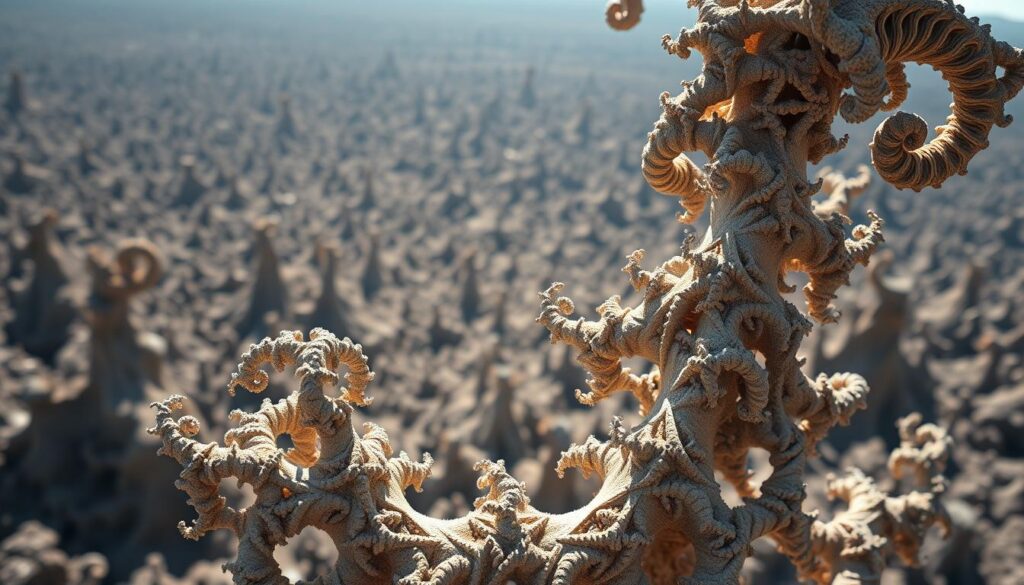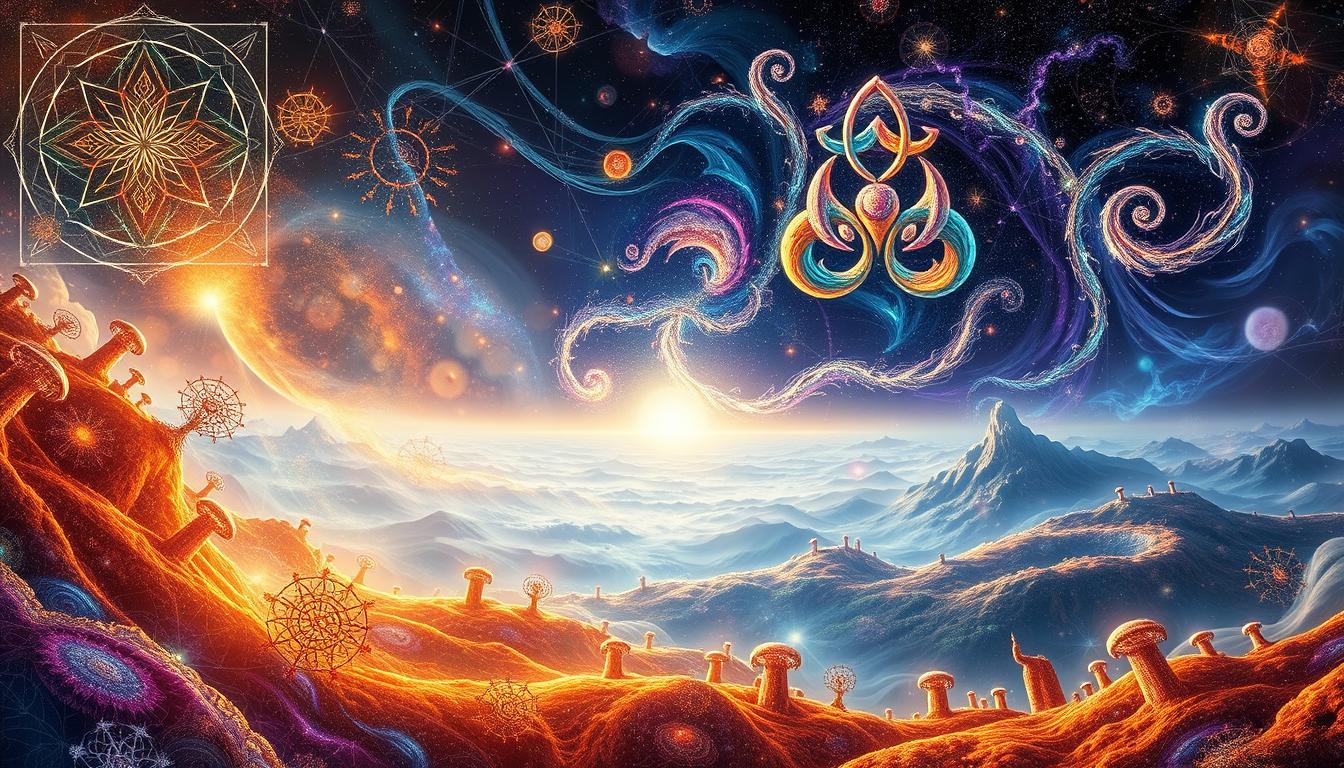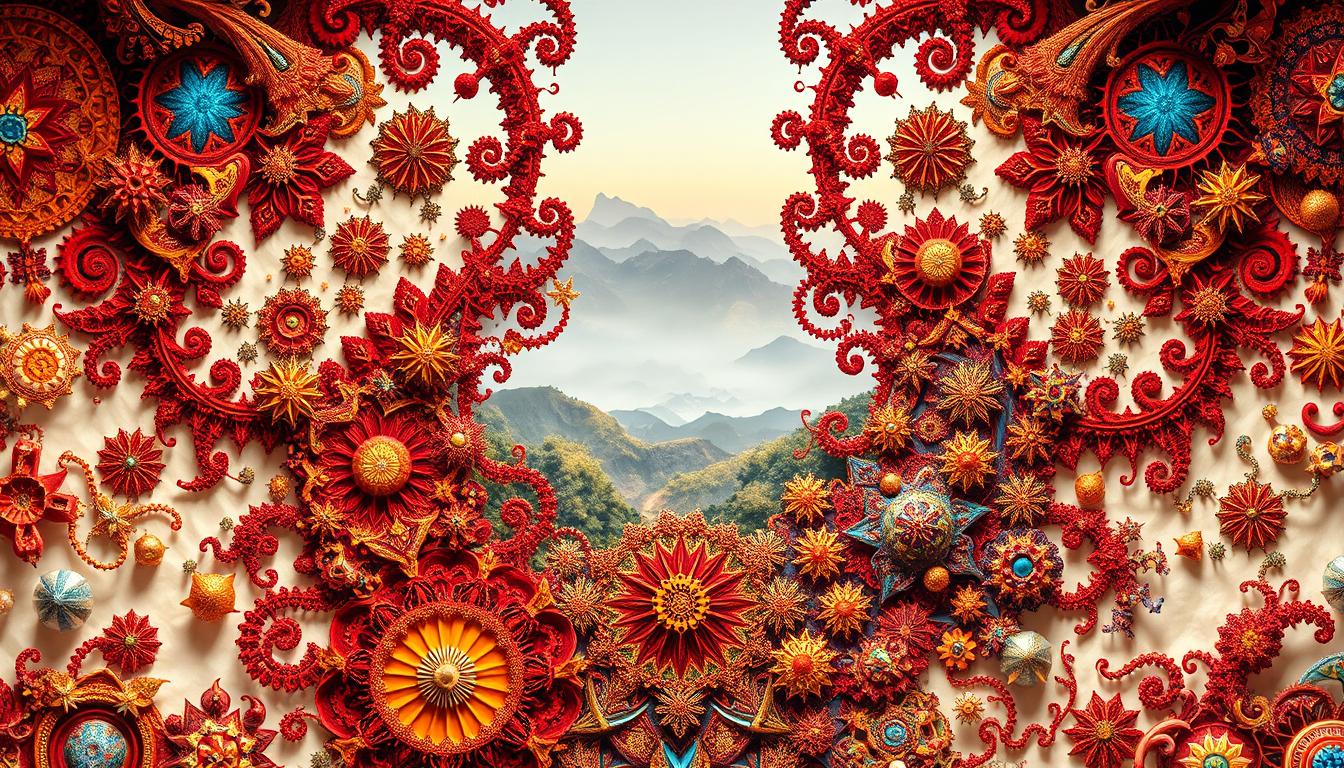Exploring fractals shows us a universal language that spans nature, math, art, and tech. These patterns appear in intricate designs all around us. They reveal complex shapes that have a lot in common.
Fractals go beyond just math; they bridge different fields with repeated patterns. They help us understand the universe better. By studying them, we see deeper links between different aspects of life.
Introduction to Fractals
Fractals are fascinating math shapes that show similar patterns no matter how close you look. They help us understand natural and human-made things better. Studying fractals lets us explore their use in everything from art to science.
Defining Fractals
Fractals are shapes that repeat endlessly, showing complex patterns at every level of zoom. This self-similarity means a tiny part looks like the entire shape. Fractals help us model and grasp the complexity found in nature, technology, and art.
Historical Context of Fractal Geometry
The study of fractals started mainly in the late 20th century, thanks to Benoit Mandelbrot. His work showed how fractals reveal complexity in nature, art, and languages. Mandelbrot’s ideas on fractals changed how we see patterns in the world, highlighting their role in depicting real-life scenes.

The Nature of Fractals in Different Disciplines
Fractals appear in many areas, showing their wide impact and nature. They are in things like ecosystems and abstract art. These intricate patterns show how various fields connect. Studying natural and mathematical fractals makes us more aware of their role in art and literature.
Fractals in Nature
Fractals are everywhere in nature, such as coastlines, mountains, and trees. These patterns repeat in smaller forms, known as self-similarity. This helps us understand the complexity of ecosystems and geological shapes.
Fractals in Mathematics
Mathematical fractals come from repeating simple steps, showing complex shapes. They help us learn about chaotic systems and surprising mathematical truths. Their unique characteristics encourage looking into patterns showing complex connections.
Fractals in Art and Literature
Many artists and authors use fractals in their creations. They reflect on deep themes using these patterns. In art, fractals create visuals similar to nature; in literature, they introduce repeating themes and variations. This approach deepens the meaning in both art and stories.
The Universal Language of Fractal Patterns
Fractal patterns show how different cultures are alike, revealing shared human experiences. These patterns are like a universal language that goes beyond cultural limits.
Understanding Patterns Across Cultures
Studying cultural patterns shows how societies see their world with common symbols. This similarity helps us communicate, showing we’re more alike than different.
Fractal Patterns in Language and Communication
Fractals are also seen in how we talk, with similar meanings echoing at many levels. This shows that our languages, even if different, have shared patterns.
Commonalities in Different Languages
Looking at languages with a fractal view highlights common traits. This indicates that various languages express similar thoughts, showing how we all connect at a basic level.
The Geometric Representation of Language
The link between language and geometry offers cool insights. It helps us understand communication better. Using geometry to show language lets us see how words connect.
This way of mapping language goes beyond old methods. It lets us explore language in many dimensions. This gives us a richer understanding of meaning.
Mapping Words in Multidimensional Space
Fractal geometry lets us see language in a unique, multi-layered way. This makes how words relate to each other clearer. It shows deeper meanings.
Techniques like the Word2Vec algorithm take this further. They not only show how words relate in space. They also help us grasp language’s complexity.
Thanks to geometric mapping, researchers and linguists can spot new patterns. This approach uncovers hidden connections in language. It makes communication and understanding better.
Fractals and the Structure of Language
Exploring fractals in language shows us cool insights into how we build sentences and sounds. Language has complex patterns similar to fractals. These patterns help us share our thoughts and feelings.
Self-Similarity in Sentence Construction
Sentence building shows patterns that repeat, just like fractals. This happens with phrases and syntax, building a structure that adds depth to what we say. It makes our thoughts neat and clear, showing language’s fractal nature.
Each part of a sentence is a smaller piece of the whole. This shows language works on many levels at once.
Phonetics and Fractal Characteristics
In phonetics, our speech has fractal characteristics too. Sounds follow patterns that repeat, linking many languages together. These shared sounds bridge different cultures, showing we’re all connected.
By studying these sound patterns, we learn more about how everyone across the globe communicates. It reveals the universal features of our speech.
Unlocking the Secrets of Reality through Fractals
The world of fractals connects deeply with many fields. Through fractals, we find patterns that link physics, biology, and cognitive science. It shows us how complex phenomena grow from simple beginnings, offering a fresh view of our universe.
Revealing Hidden Connections
Fractals help us see connections in various subjects. They suggest a universal code exists beneath reality. Through fractals, we explore patterns in:
- Physics: Uncovering the recurring themes of chaos and order
- Biology: Understanding patterns in growth and evolution
- Cognitive Science: Mapping cognitive structures and their interplay with language
By studying these links, we better understand the world. It shows everything is connected, leading to a more complete view of life.
Implications for Understanding Consciousness
Looking at consciousness through fractals opens new doors. This journey combines science with philosophy. Researchers explore:
- The nature of human thought processes
- How language mirrors cognitive patterns
- The fractal dimensions of emotional experiences
This research not only deepens our knowledge of consciousness. It also makes us appreciate our complex experiences more.
The Universe as a Code: Fractals in Cosmology
Looking at the universe through fractals opens up new views in cosmology. Fractal patterns repeat themselves at different sizes, hinting the universe works like a complex code. Understanding this code helps researchers learn about the deep rules that control all parts of reality.
Understanding Fundamental Principles of Existence
Fractals connect math to the physical world, showing how the universe might be a code. Through galaxy structures to particle formations, these patterns show up in all levels of existence. This repeating nature suggests there’s a basic link across different phenomena, making cosmology clearer to us.
Researching the universe’s code lets scientists study the connections between stars and the forces forming them. This helps us grasp important ideas in cosmology, like where the universe came from and how it changes. These core rules propose new ways to see our cosmos, challenging old beliefs.
The Role of Technology in Analyzing Fractals
In the world of linguistics, technology has changed how we see complex patterns in language. Thanks to Natural Language Processing (NLP), we now use fractals to unpack the complexity of human communication. This makes it simpler to pull meaning from language and spot patterns.
Natural Language Processing and Fractal Patterns
NLP technology has given us new insights into the structure of language. By looking at fractal patterns, we see repeat trends in sentences and words. This helps us break down language in a deeper way.
Using the Word2Vec Algorithm
The Word2Vec algorithm shows us how technology maps words in multi-dimensional spaces. It keeps track of word relationships across languages. Seeing these links through fractals gives researchers a clear view of how language and meaning intertwine.
Fractal Patterns in Ecosystems and Nature
Fractal patterns are key in understanding ecosystems’ organization and complexity. They show how nature arranges itself, following mathematical principles. Studying the shapes and structures in our environment helps us find connections within natural forms.
From Tree Branching to Coastlines
Tree branching shows fractal patterns in nature, showing self-similarity across scales. Each branch divides into smaller ones, reflecting the tree’s overall structure. This helps trees get maximum sunlight and resources for growth.
Coastlines show irregular forms measured by fractal dimensions. The details of coastlines change with scale, showing that even chaotic structures follow specific principles. Understanding these patterns helps us see how ecosystems adapt and succeed.
Future Directions in Fractal Research
Looking into future fractal research opens up thrilling paths in many areas. It has the power to change our tech and how we learn. We’re looking at how it can make a difference in AI, linguistics, and education.
Potential Applications in AI and Linguistics
Fractal patterns could take artificial intelligence to the next level. By using fractal geometry, AI could get better at understanding nuances in language. This could make our devices communicate like humans more smoothly.
Research in fractals might revolutionize our interaction with machines. It could make talking to devices feel more natural and easy.
Educational Tools and Psychological Theories
Fractals could also reshape how we learn languages. By adding fractal analysis to learning tools, we can update old teaching methods. This aligns well with how our minds grasp language.
New teaching strategies could make learning more effective and fun. Using fractals, teachers could create lessons that students really get into. It’s a big chance to make learning resources that truly stand out.
Challenges in Understanding Fractal Dimensions
The study of fractal dimensions in language is tough. Language has many layers and often resembles itself in parts, making analysis hard. It demands special methods to grasp all the subtle details.
Complex Systems and Language
Language systems show fractal dimensions in complicated ways. They have repeating patterns across different scales. To study this, researchers must look at it from many angles.
Understanding these complex patterns helps us see how parts of language connect. But, this task is not easy for those studying it.
Conclusion
Studying fractals shows us a deep story that’s all around us. They act like a universal language, connecting different areas. This includes language, nature, and technology. By looking at fractal patterns, we learn new things. This helps us understand complex things better, like languages and ecosystems.
This adventure into fractal geometry shows us amazing patterns. It also shows us how different subjects are linked together. As we keep learning, what we find could change how we see consciousness, communication, and reality.
Fractals are very important, and we should keep exploring them. They offer a chance for new breakthroughs. These breakthroughs could help us see the universe in new ways.



